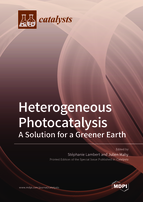Heterogeneous Photocatalysis: A Solution for a Greener Earth
A special issue of Catalysts (ISSN 2073-4344). This special issue belongs to the section "Photocatalysis".
Deadline for manuscript submissions: closed (10 April 2022) | Viewed by 46448
Special Issue Editors
Interests: heterogeneous (photo)catalysis; sol-gel process; environmental engineering; inorganic biomaterials
Special Issues, Collections and Topics in MDPI journals
Interests: Heterogeneous photocatalysis, sol-gel process, thin inorganic films, SiO2, TiO2, water and air treatment
Special Issues, Collections and Topics in MDPI journals
Special Issue Information
Dear Colleagues,
Since the beginning of the industrial era, various human activities have steadily increased, leading to rapid technological developments and a high population growth. As consequence, the expanding industry has heavily polluted the atmosphere, soil, and water, with negative consequences for humans and environment. Indeed, major pollution can cause human diseases like breath problems, cardiovascular problems, cancer, neurobehavioral disorders. It can also affect global warming and the associated climate change and sea level rise and seriously damage animals and flora. The main pollutants are aromatic compounds, pesticides, chlorinated compounds, SOx, NOx, heavy metals, and petroleum hydrocarbons.
In order to decrease pollution emissions, various chemical, physical, and biological treatment methods have been developed. The major technics for treating wastewater are based on wastewater treatment plants using dry cleaning, decantation, and biological treatments. Sometimes, pollutant molecules are not eliminated by these processes, therefore other technics can be used as secondary treatments to remove these small residual fractions of pollution. Among these methods, photocatalysis is a technic well developed in the past years. Through a photocatalyst and light, photocatalysis allows the production of highly reactive species that can react and decompose organic molecules, yielding, in the best case, the final decomposition products CO2 and H2O. The most commonly used photocatalysts are titanium dioxide (TiO2), zinc oxide (ZnO), tin oxide (SnO2).
In this Special Issue entitled "Heterogeneous photocatalysis: a solution for a greener Earth?", we welcome all kind of papers (research papers, reviews, or communications) dealing with innovative photocatalytic processes for environmental applications. The papers can concern the photocatalytic degradation of pollutants in water, air, or soil, using the photocatalytic process for the valorization of wastes or the production of green energy.
Prof. Dr. Stéphanie LambertDr. Julien Mahy
Guest Editors
Manuscript Submission Information
Manuscripts should be submitted online at www.mdpi.com by registering and logging in to this website. Once you are registered, click here to go to the submission form. Manuscripts can be submitted until the deadline. All submissions that pass pre-check are peer-reviewed. Accepted papers will be published continuously in the journal (as soon as accepted) and will be listed together on the special issue website. Research articles, review articles as well as short communications are invited. For planned papers, a title and short abstract (about 100 words) can be sent to the Editorial Office for announcement on this website.
Submitted manuscripts should not have been published previously, nor be under consideration for publication elsewhere (except conference proceedings papers). All manuscripts are thoroughly refereed through a single-blind peer-review process. A guide for authors and other relevant information for submission of manuscripts is available on the Instructions for Authors page. Catalysts is an international peer-reviewed open access monthly journal published by MDPI.
Please visit the Instructions for Authors page before submitting a manuscript. The Article Processing Charge (APC) for publication in this open access journal is 2700 CHF (Swiss Francs). Submitted papers should be well formatted and use good English. Authors may use MDPI's English editing service prior to publication or during author revisions.
Keywords
- Photocatalysis
- environmental catalysis
- micropollutants
- waste waters
- polluted gaseous emissions
- sol-gel process
- doped photocatalysts
- UV light
- visible light







